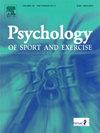Interactive effects of perfectionism on competitive golf performance: A multi-level analysis
IF 3.3
2区 心理学
Q2 HOSPITALITY, LEISURE, SPORT & TOURISM
引用次数: 0
Abstract
Perfectionism is a multidimensional personality characteristic comprised of two higher-order factors termed perfectionistic strivings (PS) and perfectionistic concerns (PC). Research has typically found perfectionistic strivings to be related to better sport performance, while concerns are usually unrelated. However, many of the tests of this relationship use non-athletes, contrived tasks, and one-off performances, and have also focused on the separate, rather than interactive, effects of PS and PC. The present study was designed to address these limitations by testing the interactive effect of indicators of PS and PC in predicting performance across two rounds of competitive golf. Eighty-nine male golf athletes (Mage = 28.42 years, SD = 11.87) completed measures of perfectionism and then competed in a regional golf competition. Their cumulative score, relative to par, across two rounds determined their performance. Hierarchical linear modelling, nesting performances within individuals, holes, and rounds, showed a significant three-way interaction between self-oriented performance perfectionism (indicator of PS), socially prescribed performance perfectionism (indicator of PC), and round (b = 0.36, SE = 0.17, p = .039). At low levels of socially prescribed performance perfectionism, self-oriented performance perfectionism predicted improved performance; however, at high levels of socially prescribed performance perfectionism, self-oriented performance perfectionism predicted poorer performance. Findings highlight the importance of assessing the relationship between perfectionism and sport performance in real-world competitive contexts over time, while accounting for the interplay between indicators of PS and PC.
完美主义对高尔夫竞技表现的互动效应:多层次分析。
完美主义是一种多维度的人格特征,由两个高阶因素组成,即完美主义的追求(PS)和完美主义的关注(PC)。研究通常发现,完美主义的努力与更好的运动表现有关,而担忧通常无关。然而,这种关系的许多测试使用的是非运动员、人为的任务和一次性的表现,并且还侧重于PS和PC的单独影响,而不是交互影响。本研究旨在通过测试PS和PC指标在预测两轮高尔夫竞技表现中的交互作用来解决这些局限性。89名男性高尔夫运动员(年龄28.42岁,SD = 11.87)完成了完美主义测试,然后参加了地区高尔夫比赛。他们在两轮比赛中相对于标准杆的累积得分决定了他们的表现。分层线性模型、个体内嵌套、洞内嵌套、圆内嵌套表现表明,自我导向型绩效完美主义(PS指标)、社会规定型绩效完美主义(PC指标)和圆之间存在显著的三向交互作用(b = 0.36, SE = 0.17, p = 0.039)。在低水平的社会规定型绩效完美主义中,自我导向型绩效完美主义预测了绩效的提高;然而,在高水平的社会规定型绩效完美主义中,自我导向型绩效完美主义预示着较差的绩效。研究结果强调了在现实世界的竞争环境中评估完美主义与运动表现之间关系的重要性,同时考虑了PS和PC指标之间的相互作用。
本文章由计算机程序翻译,如有差异,请以英文原文为准。
求助全文
约1分钟内获得全文
求助全文
来源期刊
CiteScore
6.40
自引率
5.90%
发文量
172
审稿时长
69 days
期刊介绍:
Psychology of Sport and Exercise is an international forum for scholarly reports in the psychology of sport and exercise, broadly defined. The journal is open to the use of diverse methodological approaches. Manuscripts that will be considered for publication will present results from high quality empirical research, systematic reviews, meta-analyses, commentaries concerning already published PSE papers or topics of general interest for PSE readers, protocol papers for trials, and reports of professional practice (which will need to demonstrate academic rigour and go beyond mere description). The CONSORT guidelines consort-statement need to be followed for protocol papers for trials; authors should present a flow diagramme and attach with their cover letter the CONSORT checklist. For meta-analysis, the PRISMA prisma-statement guidelines should be followed; authors should present a flow diagramme and attach with their cover letter the PRISMA checklist. For systematic reviews it is recommended that the PRISMA guidelines are followed, although it is not compulsory. Authors interested in submitting replications of published studies need to contact the Editors-in-Chief before they start their replication. We are not interested in manuscripts that aim to test the psychometric properties of an existing scale from English to another language, unless new validation methods are used which address previously unanswered research questions.

 求助内容:
求助内容: 应助结果提醒方式:
应助结果提醒方式:


